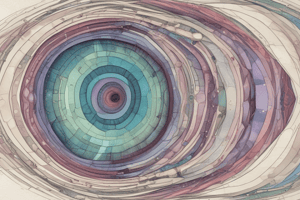Podcast
Questions and Answers
What structure forms the primordium of the urinary bladder and rectum?
What structure forms the primordium of the urinary bladder and rectum?
- Allantois
- Primitive streak
- Yolk sac
- Cloaca (correct)
What is the role of the yolk stalk during the folding of the embryo?
What is the role of the yolk stalk during the folding of the embryo?
- Connects the foregut and hindgut
- Attaches the yolk sac to the midgut (correct)
- Forms the connecting stalk
- Encases the allantois
Which embryonic structure is partially incorporated into the embryo and contributes to the formation of the cloaca?
Which embryonic structure is partially incorporated into the embryo and contributes to the formation of the cloaca?
- Cloacal membrane
- Connecting stalk
- Umbilical vesicle
- Allantois (correct)
During horizontal plane folding, what does the incorporation of part of the endoderm into the embryo create?
During horizontal plane folding, what does the incorporation of part of the endoderm into the embryo create?
What remains in the connecting stalk after the incorporation of the allantois into the embryo?
What remains in the connecting stalk after the incorporation of the allantois into the embryo?
What is the primary shape transformation of the embryonic disc as it folds during the fourth week of development?
What is the primary shape transformation of the embryonic disc as it folds during the fourth week of development?
Which structure is formed as part of the head fold process during ventral folding?
Which structure is formed as part of the head fold process during ventral folding?
What connection is maintained through the vitelline duct during the embryonic folding process?
What connection is maintained through the vitelline duct during the embryonic folding process?
What happens to the caudal eminence as it folds during embryo development?
What happens to the caudal eminence as it folds during embryo development?
Which of the following accurately describes the effect of the head fold on adjacent structures?
Which of the following accurately describes the effect of the head fold on adjacent structures?
What is the primary result of cephalocaudal folding during embryonic development?
What is the primary result of cephalocaudal folding during embryonic development?
Which of the following structures is established during lateral folding of the embryonic disc?
Which of the following structures is established during lateral folding of the embryonic disc?
During the process of embryo folding, what structure directly undergoes transformation to form the hindgut?
During the process of embryo folding, what structure directly undergoes transformation to form the hindgut?
What key event occurs as the heart tube migrates ventrally during embryonic folding?
What key event occurs as the heart tube migrates ventrally during embryonic folding?
How does horizontal plane folding contribute to overall embryonic development?
How does horizontal plane folding contribute to overall embryonic development?
How does the lateral folding of the embryo contribute to the body plan?
How does the lateral folding of the embryo contribute to the body plan?
What is the fate of the umbilical vesicle after the formation of the embryo?
What is the fate of the umbilical vesicle after the formation of the embryo?
Which embryonic structures are primarily responsible for ventral body wall formation?
Which embryonic structures are primarily responsible for ventral body wall formation?
What occurs to the connection between the yolk sac and the primitive gut during development?
What occurs to the connection between the yolk sac and the primitive gut during development?
What effect does the caudal folding of the embryo have on its structural organization?
What effect does the caudal folding of the embryo have on its structural organization?
What structures are formed as a result of the horizontal plane folding of the embryo?
What structures are formed as a result of the horizontal plane folding of the embryo?
Which component primarily contributes to the formation of the primitive gut during embryonic development?
Which component primarily contributes to the formation of the primitive gut during embryonic development?
What is the primary function of the allantois during early development?
What is the primary function of the allantois during early development?
What mistakenly illustrates the role of somites during lateral folding?
What mistakenly illustrates the role of somites during lateral folding?
What distinguishes the stages of the yolk sac and its role in the human embryo?
What distinguishes the stages of the yolk sac and its role in the human embryo?
Flashcards are hidden until you start studying
Study Notes
Embryonic Folding
- The embryonic disc begins to fold during the 4th week of development due to its increasing size.
- Folding occurs in both the median and horizontal planes, transforming the flat trilaminar embryonic disc into a C-shaped, cylindrical embryo.
Folding in Median Plane
- Cephalocaudal folding: Forms the head and tail folds.
- The head fold incorporates part of the endodermal layer into the developing head region, forming the foregut.
- The oropharyngeal membrane and heart are also carried ventrally.
- The developing brain becomes positioned at the most cranial part of the embryo.
- The cardiogenic area lies caudal to the buccopharyngeal membrane, with the pericardial cavity located ventrally and the heart tube dorsal to the pericardial cavity.
- The septum transversum lies caudal to the cardiogenic area.
- The caudal end of the heart tube comes to lie cranially, connecting with the dorsal aortae.
- The original cranial end of the heart tube lies caudally and receives three pairs of veins.
- Caudal folding: Forms the tail fold.
- The endodermal germ layer is incorporated into the caudal end of the embryo, forming the hindgut.
- The terminal part of the hindgut expands to form the cloaca, the primordium of the urinary bladder and rectum.
- The primitive streak lies caudal to the cloacal membrane.
- After tail folding:
- the connecting stalk, primordium of the umbilical cord, is attached to the ventral surface of the embryo.
- Allantois, a diverticulum of the yolk sac, is partially incorporated into the embryo.
- The cloacal membrane, allantois, and connecting stalk are carried to the ventral surface of the embryo.
Folding in the Horizontal Plane
- Folding on the sides of the embryo produces right and left lateral folds.
- Driven by rapid growth of the spinal cord and somites.
- Ventrolateral rolling of the edges of the embryonic disc forms a roughly cylindrical embryo.
- Incorporates part of the endoderm into the embryo as the midgut.
- The umbilical vesicle remains attached to the midgut via a narrow omphaloenteric duct (yolk stalk).
- Folding of the embryo in the horizontal plane forms the primordia of the lateral and ventral body walls.
- As the amnion expands, it envelops the connecting stalk, yolk stalk, and allantois, forming an epithelial covering for the umbilical cord.
Yolk Sac and Allantois
- Formation of the head and tail folds encloses parts of the yolk sac within the embryo, lined with endoderm. This forms the primitive gut, which initially has wide communication with the yolk sac.
- The cranial portion forms the foregut, the caudal portion forms the hindgut, and the intervening part forms the midgut.
- Communication with the yolk sac progressively narrows, resulting in a smaller yolk sac called the definitive yolk sac.
- The narrow channel connecting it to the gut forms the vitello-intestinal duct, which eventually elongates and disappears.
- The amniotic cavity expands greatly, surrounding the embryo on all sides and allowing the embryo to float within it.
- Incorporation of the allantois into the body of the embryo forms the cloaca. The distal portion of the allantois remains in the connecting stalk.
- By the fifth week, the yolk sac duct, allantois, and umbilical vessels are restricted to the umbilical region.
- In humans, the yolk sac is vestigial and only plays a nutritive role in early development.
- The external appearance of the embryo is significantly affected by the formation of the brain, heart, liver, somites, limbs, ears, nose, and eyes.
Development During the 4th-8th Weeks
- This is the most critical period of development, as most essential external and internal structures are formed.
- Disturbances during this period can lead to major birth defects.
- By the end of the fourth week, the embryo has approximately 28 somites, with the main external features being the somites and pharyngeal arches.
- The age of the embryo is usually expressed in somites.
- During the second month, the age of the embryo is indicated by crown-rump length (CRL) in millimeters.
Limb Development
- By the beginning of the fifth week, forelimbs and hindlimbs appear as paddle-shaped buds.
- The forelimbs are positioned dorsal to the pericardial swelling at the level of the fourth cervical to the first thoracic somites, explaining their innervation by the brachial plexus.
- Hindlimb buds appear slightly later, caudal to the attachment of the umbilical stalk at the level of the lumbar and upper sacral somites.
- The terminal portions of the buds flatten, and a circular constriction separates them from the proximal, more cylindrical segment.
- Four radial grooves separating five slightly thicker areas appear on the distal portion of the buds, foreshadowing the formation of the digits (these grooves are known as rays).
- They appear first in the hand region and then shortly afterward in the foot, as the upper limb is slightly more advanced in development.
- A second constriction divides the proximal portion of the buds into two segments, giving rise to the three parts characteristic of the adult extremities.
Embryonic Folding
- During the fourth week of development, the embryonic disc folds in the median and horizontal planes.
- The folding process converts the initially flat trilaminar disc into a C-shaped, cylindrical embryo.
- Folding in the median plane establishes the head and tail folds, while folding in the horizontal plane forms the lateral folds.
Head Fold
- As the head fold develops, a portion of the endodermal layer is incorporated into the embryonic head region, forming the foregut.
- This folding process also carries the oropharyngeal membrane and heart ventrally.
- The developing brain becomes the most cranial part of the embryo.
Tail Fold
- When the caudal eminence folds ventrally, part of the endodermal germ layer is incorporated into the caudal end of the embryo, forming the hindgut.
- The terminal portion of the hindgut expands to form the cloaca, the primordium of the urinary bladder and rectum.
- After tail folding, the connecting stalk (primordium of the umbilical cord) is attached to the ventral surface of the embryo.
- The allantois, a diverticulum of the yolk sac, is partially incorporated into the embryo.
Horizontal Folding
- Folding on the sides of the embryo produces right and left lateral folds, driven by the rapid growth of the spinal cord and somites.
- This ventrolateral rolling of the embryonic disc edges forms a roughly cylindrical embryo.
- Horizontal folding incorporates part of the endoderm into the embryo as the midgut.
- The umbilical vesicle remains attached to the midgut via a narrow omphaloenteric duct (yolk stalk).
- The primordia of the lateral and ventral body walls are formed during horizontal folding.
- As the amnion expands, it envelops the connecting stalk, yolk stalk, and allantois, forming an epithelial covering for the umbilical cord.
Yolk Sac and Allantois
- Formation of the head and tail folds encloses parts of the yolk sac within the embryo, lined with endoderm, forming the primitive gut.
- The primitive gut initially has wide communication with the yolk sac.
- The part cranial to the communication forms the foregut, caudal to the communication forms the hindgut, and the intervening part forms the midgut.
- Communication with the yolk sac becomes progressively narrower, leading to a smaller yolk sac called the definitive yolk sac.
- A narrow channel connecting the definitive yolk sac to the gut forms the vitello-intestinal duct, which elongates and eventually disappears.
- The amniotic cavity expands greatly, surrounding the embryo on all sides, and the embryo begins floating within it.
- The allantois is incorporated into the body of the embryo, forming the cloaca.
- The distal portion of the allantois remains in the connecting stalk.
Development During Months 2-5
- By the end of the fourth week, the embryo has approximately 28 somites, and the main external features are the somites and pharyngeal arches.
- The age of the embryo is typically expressed in somites.
- After the second month, the age of the embryo is indicated by the crown-rump length (CRL) measured in millimeters.
- During the second month, the embryo undergoes significant external changes, including an increase in head size and the formation of limbs, face, ears, nose, and eyes.
- By the beginning of the fifth week, forelimbs and hindlimbs appear as paddle-shaped buds.
- The forelimb buds are located dorsal to the pericardial swelling, while the hindlimb buds are slightly caudal to the attachment of the umbilical stalk.
- As the limb buds grow, their terminal portions flatten, a circular constriction separates the proximal segment, and four radial grooves appear, foreshadowing digit formation.
- These grooves, known as rays, appear in the hand region first, followed by the foot.
- A second constriction divides the proximal portion of the buds into two segments, forming the three characteristic parts of the adult extremities.
Studying That Suits You
Use AI to generate personalized quizzes and flashcards to suit your learning preferences.





